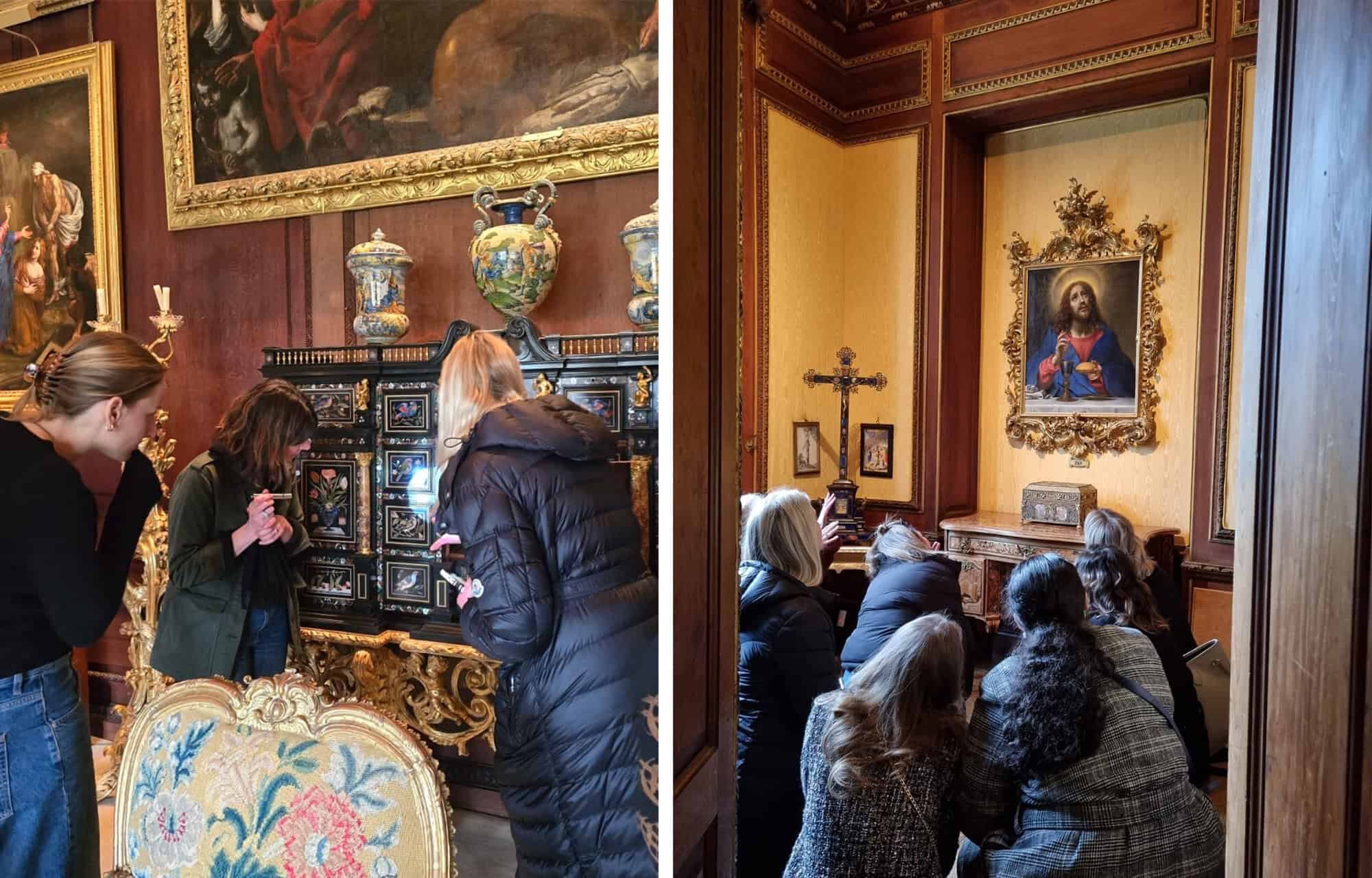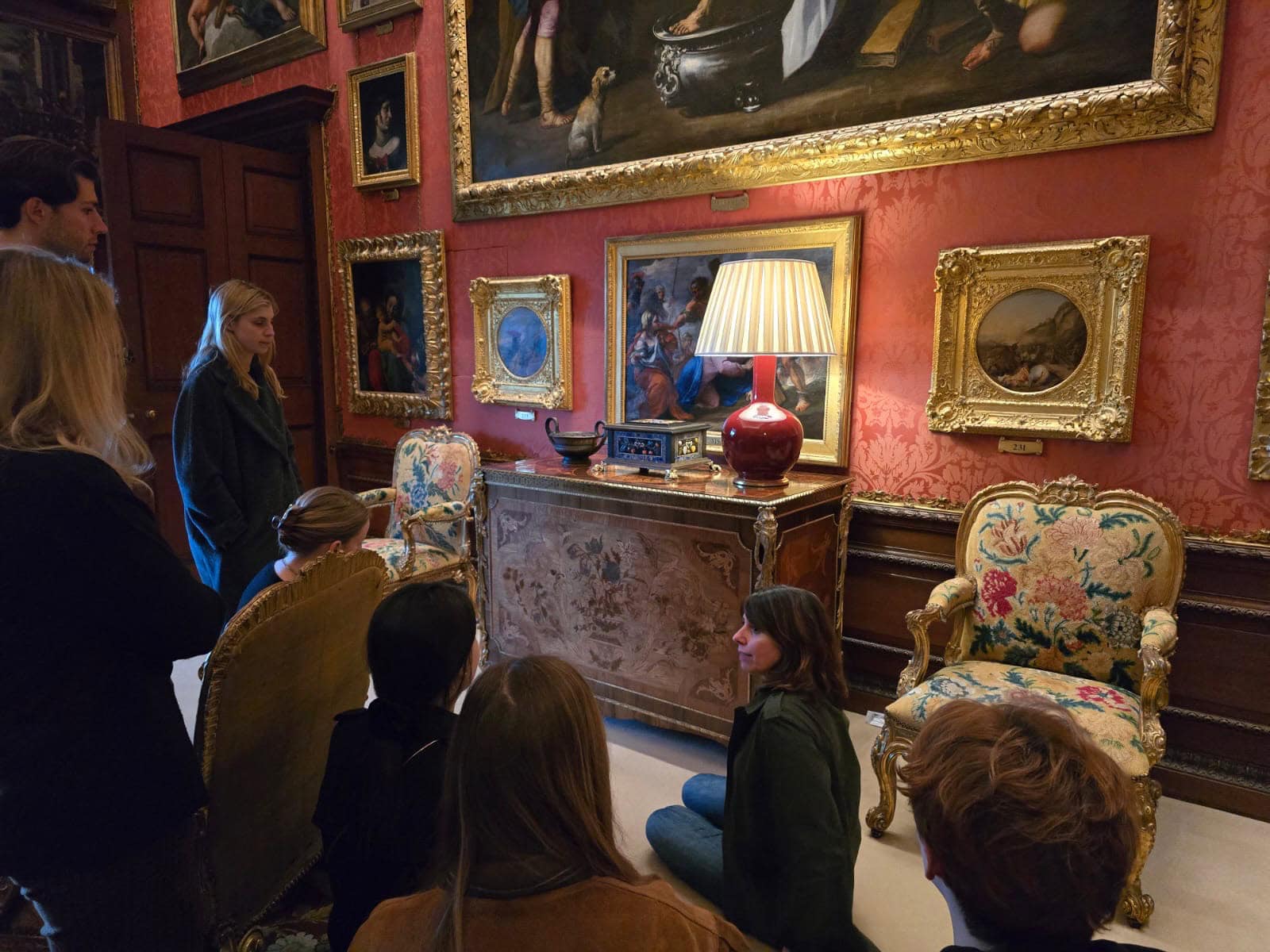The MA in Fine and Decorative Art and Design at Sotheby’s Institute of Art is rooted in the principle of object-based learning. One of the highlights of the program is the annual visit to Burghley House in Lincolnshire. Here, faculty share historical and contextual insights that help students engage with the objects and interiors they encounter.
The visit to Burghley House is one of the much-anticipated highlights of the program. Located in Lincolnshire, the magnificent sixteenth-century Elizabethan country house is home to priceless art treasures including hundreds of Old Master paintings, rare tapestries, Asian porcelain and precious furniture. Some may, of course, also know the house as one of the filming locations for the Netflix series The Crown (it stood in for Windsor Castle).
The Institute is lucky to enjoy privileged access to Burghley, visiting when the house is closed to the public. Students have the extraordinary opportunity to spend the day alone in its spectacular state rooms and go beyond the protective ropes to examine the art collections at very close range.
The visit generally gets off to a dramatic start with the ascent of the dark and breathtaking Hell Staircase. Painted by the celebrated Baroque artist Antonio Verrio in 1697, its ceiling depicts the gods of Olympus observing tormented souls at the entrance to Hell, aptly shaped as a cat’s gaping mouth. The walls, completed a century later by Thomas Stothard, represent episodes from the stories of Orpheus and Eurydice, and Antony and Cleopatra. In sharp contrast, the imposing and light-filled next room, the Heaven Room—also the work of Verrio—shows Olympian deities assembled amid a grand classical architectural setting to witness in amusement Venus’ extramarital dalliance with the god of war, Mars.
The study trip to Burghley House exemplifies the immersive, object-based learning at the heart of the MA in Fine and Decorative Art and Design. As an alumnus and Consultant Lecturer on the program, and a Consultant for Old Master Paintings at Sotheby’s, Adam Busiakiewicz explains, “The program was exactly what I dreamed of: a practical approach to gaining knowledge to pursue the study of art through an object-based approach.”
He continues, “The skills I learned at the Institute are still relevant for cataloguers and researchers at the auction house today, and not many MA programs are as applicable as this one.”
One of the greatest joys of the visit is the chance to look at art very closely. Students are allowed to open some of Burghley’s precious furniture, admire its decoration at close range and discover hidden compartments. Among many wonderful pieces is a seventeenth-century ebony cabinet with pietra dura plaques made in the Medici workshops, a gift from Archduke Cosimo III of Tuscany to Earl Cecil. Another standout is a seventeenth-century floral marquetry cabinet on stand attributed to the French royal furniture maker Pierre Gole, which reveals a mirrored stage-set interior that always elicits awe from students upon discovery.

The collection of Old Masters is equally superb and considered one of the finest in private ownership. Largely assembled as part of the Earls of Exeter’s lengthy Grand Tours, highlights include Artemisia Gentileschi’s Susanna and the Elders, purchased by the 9th Earl while in Rome, and Orazio Gentileschi’s Virgin and Child, formerly in the possession of Pope Clement XIV. The collection also includes notable eighteenth-century British portraits by Godfrey Kneller, Thomas Gainsborough and Thomas Lawrence. Of these, Lawrence’s charming depiction of the three children of the 1st Marquess of Exeter reflects the growing admiration for childhood and innocence that found full expression in early nineteenth-century portraiture.
Burghley also houses a world-class collection of Asian and European ceramics, totalling more than 800 pieces. Among them are Japanese Imari and Kakiemon wares—objects of rarity and luxury, and among the most decorative and collectable of Asian ceramics. Their presence at Burghley is a powerful reminder of the global networks of exchange that influenced the production and consumption of art in the early modern period. Much has been written about the European taste for Asian luxury goods such as porcelain, lacquer and textiles. Mobilised as tangible manifestations of personal wealth, culture and gentility, these objects were avidly consumed by European elites eager to demonstrate transnational aesthetic tastes.
The visit also serves as a powerful reminder of the importance of considering the relationship between art collections and the historic sites for which they were created. Burghley prompts students to interrogate patterns of patronage and collecting, the cultural values attached to provenance, and how these elements relate to today’s collecting paradigms.

Importantly, the art on display at Burghley is not solely the result of male tastes and ambitions. The fortunes of the collection were significantly shaped by the 5th Earl’s marriage to Anne Cavendish, the only daughter of the 3rd Earl of Devonshire. A significant collector in her own right, the Countess accompanied her husband on two Grand Tours, acquiring several Italian Old Masters and showing a particular taste for Asian porcelain and lacquer. A century later, Hannah-Sophia Chambers, daughter of a wealthy businessman and wife of the 8th Earl, expanded the ceramics collection further, particularly with Meissen porcelain. Burghley invites students to question the role of gender in the formation of early modern collections and to see how women—albeit elite ones—used art collecting and patronage as a means of self-actualisation.
Through direct access to extraordinary objects and interiors, students experience first-hand the intellectual rewards of learning through objects—an approach that continues to shape the future of art scholarship and collecting today.
